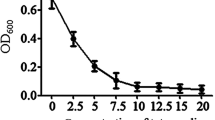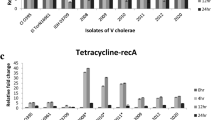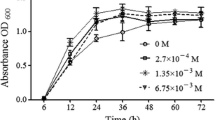Abstract
Purpose
To detect the sulfonamide resistance of Vibrio splendidus strain Vs, and characterize the factors that regulate the expression of sulfonamide resistance gene sulVs.
Methods
Minimal inhibitory concentration was measured using growth inhibition method, gene expression was measured using real-time reverse transcriptase PCR, reactive oxygen species (ROS) production under Cu2+ or Cu2+/NAC conditions was measured using an excitation wavelength of 485 nm, and an emission wavelength of 525 nm, and the binding of sulVs promoter and the transcriptional factor ArcA was measured using electrophoretic mobility shift assay (EMSA).
Result
sulVs gene was cloned and its expression was upregulated to 6.98- and 3.57-fold in the presence of sulfadiazine and sulfamethoxazole, respectively. Moreover, Cu2+ could also upregulate the expression of sulVs to 14.27-fold, the production of ROS to 4.37-fold, and the expressions of antioxidant-related genes and a transcriptional regulator arcA gene. After addition of N-Acetyl-L-cysteine, a ROS inhibitor, the production of ROS decreased to 53.1%, and the expression of arcA gene was also downregulated to 26%. EMSA showed that the purified recombinant ArcA could directly bind to the promoter region of sulVs with specificity.
Conclusion
V. splendidus strain Vs showed sulfonamide resistance due to sulVs, and Cu2+ could increase the level of ROS followed by ArcA activation as a transcriptional factor to increase the expression of sulVs.







Similar content being viewed by others
References
Ali H, Khan E, Sajad M (2013) Phytoremediation of heavy metals-concepts and applications. Chemosphere 91:869–881
Antunes P, Maehado J, Sousa JC, Peixe L (2005) Dissemination of sulfonamide resistance genes (sul1, sul2, and sul3) in Portuguese Salmonella enterica strains and relation with integrons. Antimicrob Agents Ch 49:836–839
Baker-Austin C, Wright MS, Stepanauskas R, McArthur JV (2006) Coselection of antibiotic and metal resistance. Trends Microbiol 14:176–182
Beceiro A, Tomás M, Bou G (2013) Antimicrobial resistance and virulence: a successful or deleterious association in the bacterial world? Clin Microbiol Rev 26:185–230
Berg J, Tom-Petersen A, Nybroe O (2005) Copper amendment of agricultural soil selects for bacterial antibiotic resistance in the field. Lett Appl Microbiol 40:146–151
Caille O, Rossier C, Perron K (2007) A copper-activated two-component system interacts with zinc and imipenem resistance in Pseudomonas aeruginosa. J Bacteriol 189:4561–4568
Daniel JD, Kohanski MA, Collins JJ (2009) Role of reactive oxygen species in antibiotic action and resistance. Curr Opinion Microbiol 12:482–489
Gao P, He S, Huang SL, Li KZ, Liu ZH, Xue G, Sun WM (2015) Impacts of coexisting antibiotics, antibacterial residues, and heavy metals on the occurrence of erythromycin resistance genesin urban wastewater. Appl Microbiol Biotechnol 99:3971–3980
Graham DW, Olivares-Rieumont S, Knapp CW, Lima L, Werner D, Bowen E (2011) Antibiotic resistance gene abundances associated with waste discharges to the Almendares River near Havana, Cuba. Environ Sci Technol 45:418–424
Gui SL, Meng XC, Zhang JL (2008) The oxygen tolerance mechanism of bifidobacteria. Sci Technol Food Ind 29:280–283
Han XY, Gao LP, Liu Q (2012) The development of NOX family proteins. Chinese Bull Life Sci 24:568–577
Helen IR, James W, Berit A, Birkbeck TH (2009) Analysis of bacterial populations in the gut of developing cod larvae and identification of Vibrio logei, Vibrio anguillarum and Vibrio splendidus as pathogens of cod larvae. Aquaculture 288:36–43
Hernando MD, Mezcua M, Femández-Alba AR, Barceló D (2006) Environmental risk assessment of pharmaceutical residues in wastewater effluents, surface waters and sediments. Talanta 69:334–342
Imlay JA (2008) Cellular defenses against superoxide and hydrogen peroxide. Annu Rev Biochem 77:755
James AT, Christopcher CF (2010) Enhanced glutathione biosynthetic capacity promotes resistance to As3+ induced apoptosis. Toxicol Lett 193:33–40
Jorgensen JH, Ferraro MJ (2009) Antimicrobial susceptibility testing: a review of general principles and contemporary practices. Clin Infect Dis 49:1749–1755
Larkin MA, Blackshields G, Brown NP, Chenna R, McGettigan PA, McWilliam H, Valentin F, Wallace IM, Wilm A, Lopez R, Thompson JD, Gibson TJ, Higgins DG (2007) Clustal W and Clustal X version 2.0. Bioinformatics 23:2947–2948
Liu R, Qiu L, Yu Z, Zi J, Yue F, Wang L, Zhang H, Teng W, Liu X, Song L (2013) Identification and characterisation of pathogenic Vibrio splendidus from yesso scallop (Patinopecten yessoensis) cultured in a low temperature environment. J Invertebr Pathol 114:144–150
Loui C, Chang AC, Lu S (2009) Role of the ArcAB two-component system in the resistance of Escherichia coli to reacte oxygen stress. BMC Microbiol 9:183
Luna MAC, Vieira ER, Okada K, Campos-Takaki GM, Nascimento AE (2015) Copper-induced adaptation, oxidative stress and its tolerance in Aspergillus niger UCP1261. Electron J Biotechnol 18:418–427
Lynch AS, Lin EC (1996) Transcriptional control mediated by the ArcA two component response regulator protein of Escherichia coli: characterization of DNA binding at target promoters. J Bacteriol 178:6238–6249
McKinney CW, Loftin KA, Meyer MT, Davis JG, Pruden A (2010) tet and sul antibiotic resistance genes in livestock lagoons of various operation type, configuration, and antibiotic occurrence. Environ Sci Technol 44:6102–6109
Mu QH, Luo Y, Sun YX, Mao DQ, Wang Q, Luo Y (2014) Occurrence of sulfonamide-, tetracycline-, plasmid-mediated quinolone- and macrolide-resistance genes in livestock feedlots in northern China. Environ Sci Pollution Res 22:6932–6940
Okoh AI, Igbinosa EO (2010) Antibiotic susceptibility profiles of some Vibrio strains isolated from wastewater final effluents in a rural community of the eastern Cape Province of South Africa. BMC Microbiol 10:143
Radermacher KA, Wingler K, Kleikers P, Altenhöfer S, Hermans JJR, Kleinschnitz C, Schmidt HHHW (2012) The 1027th target candidate in stroke: will NADPH oxidase hold up? Exp Transl Stroke Med 4:11
Richardson BJ, Lam PK, Martin M (2005) Emerging chemicals of concern: pharmaceuticals and personal care products (PPCPs) in Asia, with particular reference to Southern China. Mar Pollut Bul 50:913–920
Salmon KA, Hung SP, Steffen NR, Krupp R, Baldi P, Hatfield GW, Gunsalus RP (2003) Global gene expression profiling in Escherichia coli K12: the effects of oxygen availability and ArcA. J Biol Chem 280:15084–15096
Santo D, Krans T, Santo CE, Elowsky CG, Domaille DW, Chang CJ, Grass G (2011a) Mechanisms of contact-mediated killing of yeast cells on dry metallic copper surfaces. Appl Environ Microbiol 77:416–426
Santo D, Krans T, Santo CE, Elowsky CG, Domaille DW, Chang CJ, Grass G (2011b) Mechanisms of contact-mediated killing of yeast cells on dry metallic copper surfaces. Appl Environ Microbiol 77:416–426
Sies H (1997) Oxidative stress: oxidants and antioxidants. Exp Physiol 82:291–295
Stokstad ELR, Jukes TH (1987) Sulfonamides and folic acid antagonists: a historical review. J Nutr 117:1335–1341
Tamura K, Dudley J, Nei M, Kumar S (2007) MEGA4: molecular evolutionary genetics analysis (MEGA) software version 4.0. Mol Biol Evol 24:1596–1599
Wang F, Cheng S, Sun K, Sun L (2008) Molecular analysis of the fur (ferric uptake regulator) gene of a pathogenic Edwardsiella tarda strain. J Microbiol 46:350–355
Wu D, Huang ZT, Yang K, Graham D, Xie B (2015) Relationships between antibiotics and antibiotic resistance gene levels in municipal solid waste leachates in Shanghai, China. Environ Sci Technol 49:4122–4128
Zhang C, Chen GW, Yang YP, Wu SY, Liu Q (2013a) Reactive oxygen species (ROS) regulates Listeria monocytegenes biofilm formation. Food Sci 34:189–193
Zhang WW, Liang WK, Li CH (2016) Inhibition of marine Vibrio sp. by pyoverdine from Pseudomonas aeruginosa PA1. J Hazard Mater 302:217–224
Zhang WW, Sun L (2007) Cloning, characterization and molecular application of a beta-agarase gene from Vibrio sp. strain V134. Appl Environ Microbiol 73:2825–2831
Zhang M, Sun K, Sun L (2008) Regulation of autoinducer 2 production and luxS expression in a pathogenic Edwardsiella tarda strain. Microbiology 154:2060–2069
Zhang WW, Yin K, Li BW, Chen LX (2013b) A glutathione S-transferase from Proteus mirabilis involved in heavy metal resistance and its potential application in removal of Hg2+. J Hazard Mater 261:646–652
Zhao GH, Ceci P, Ilari A, Giangiacomo L, Laue TM, Chiancone E, Chasteen ND (2002) Iron and hydrogen peroxide detoxification properties of DNA-binding protien from starved cells a ferritin-like DNA-binding protein of Escherichia coli. J Biol Chem 277:27689–27696
Funding
This work was financially supported by the National Natural Science Foundation of China (41676141), and the K.C. Wong Magna Fund at Ningbo University.
Author information
Authors and Affiliations
Corresponding author
Ethics declarations
Conflict of interest
The authors declare that they have no conflict of interest.
Additional information
Publisher’s note
Springer Nature remains neutral with regard to jurisdictional claims in published maps and institutional affiliations.
Rights and permissions
About this article
Cite this article
Liu, H., Song, T., Lv, T. et al. Cu2+ regulated sulfonamides resistance gene (sul) via reactive oxygen species induced ArcA in a pathogenic Vibrio splendidus. Ann Microbiol 69, 829–838 (2019). https://doi.org/10.1007/s13213-019-01475-6
Received:
Accepted:
Published:
Issue Date:
DOI: https://doi.org/10.1007/s13213-019-01475-6




